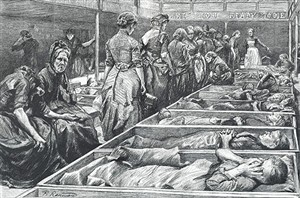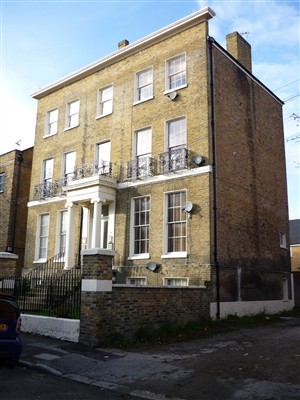
Women at the Hanbury Street shelter slept in wooden boxes on a mattress of seaweed
© unknown

Florence Soper Booth, daughter-in-law of William, was in charge of the new department of rescue work
© unknown

The house which still stands at 13 Laura Place was an early Salvation Army rescue home
© Natasha Lewer
By Natasha Lewer
Fallen women
A Whitechapel Salvationist named Elizabeth Cottrill began to take “poor, fallen girls” into her home in the early 1880s. These were women who had fallen into prostitution, or seen to be at risk of it, or who were otherwise homeless, destitute and vulnerable. Mrs Cottrill’s house at 1 Christian Street, off Commercial Road – already home to her baker husband and six children – soon became overcrowded, and a rented house was found in nearby Hanbury Street for the women. Later renamed Hope Town, the shelter at 194 Hanbury Street, off Brick Lane, was the Salvation Army’s first rescue home and women’s refuge.
Contemporary reports of the women's refuge in Hanbury Street show that as many as 500 women could shelter there at night. They slept in rows of open-topped wooden boxes, on a mattress of seaweed, while for bedclothes they had "a large leather sheet with a strap round the neck to prevent its slipping off". They were given hot tea, and food, and attended a "rousing rollicking" evening service. They also sewed and knitted "trifles", which were sold to pay for their board and lodging.
Florence Booth to the rescue
William Booth decided to put his shy 22-year-old daughter-in-law, Florence Soper Booth, in charge of this new area of ‘rescue work’. She had a great deal to learn, very fast, admitting later that she "had not then even realised that there were such people as prostitutes".
Other charitable organisations were already involved in rescue work, and Florence Soper Booth “left the trees and greenness of Clapton Common and journeyed by tram to Whitechapel” so as to see what they were doing. She was horrified by what she found: unforgiving, prison-like institutions, where the women were expected to do laundry work for up to three years to pay penance for their sins. “Bolts and bars, bare, dismal rooms, high walls, no occupation but that of laundry work, seemed to explain this discouragement. I could not imagine myself becoming any better for a long stay in similar circumstances,"
she wrote.
Freedom from rules
She determined that the emphasis at the Salvation Army rescue homes would be on creating an environment where the women would receive love and support, and would be helped to earn their own living so as to “return to respectable society“. She was keen to keep rules and regulations to the minimum, adding, “I am firmly convinced of the wisdom of leaving them all free to quit the refuge at any moment. Those who do not desire to stay are better away.” As they became more established, perhaps inevitably they became more rule-bound, and in 1892 Orders and Regulations for Rescue Homes was published.
A new headquarters
The new department of Women’s Social and Rescue Work was officially inaugurated in 1884, with headquarters at 259 Mare Street. It was run by Florence Soper Booth assisted by General Adelaide Cox. Later renamed the department of Women’s Social Work, it was moved to temporary buildings in Lower Clapton Road and finally into new, purpose-built headquarters at 280 Mare Street in 1911.
Hackney refuges
Refuges and rescue homes were established throughout London, including some in Hackney. Women were housed at 259 Mare Street (where the Women’s Social and Rescue Work was also based); at 183 Amhurst Road; at Lanark House, Laura Place; and at Crossways, 13 Laura Place.
A couple of rescue homes also accepted women with children: the original refuge at 194 Hanbury Street had a separate shelter for mothers and children attached to it, and children were also taken at Lanark House. Soon it became obvious that there was a need for specialist shelters for expectant mothers, and this became the next development in the Salvation Army’s network of social services.
Image of the Hanbury Street shelter provided courtesy of www.workhouses.org.uk.